
Top Sales Activity Tracking Tools for 2025
Here are the top sales activity tracking tools for 2025, designed to monitor performance, optimize strategies, and increase sales efficiency.
Are you a sales leader looking to boost your team’s performance and maximize revenue? But there could often be something or another as a barrier to achieving your goals. Well, here’s some food for thought: you are unknowingly leaving money on the table because you need to track your sales activities effectively.
When you do not have a proper sales activity tracking mechanism, it leads to:
- crucial insights slipping through the cracks
- missed opportunities
- inefficient processes
- a hit to your bottom line
There’s a powerful solution at your fingertips: sales activity tracking tools.
So, get ready to understand that this game-changing tool can revolutionize how you monitor and manage your team’s sales activities, helping you stay on top of every important interaction, deal, and opportunity.

What is Sales Activity Tracking?
Sales activity tracking systematically monitors and records various actions, interactions, and progress related to the sales process. It involves closely monitoring the key metrics, stages, and milestones that drive successful sales outcomes.
Tracking these activities allow you to:
- gain valuable insights into your team’s performance
- identify bottlenecks
- make data-driven decisions
Let’s say your team is responsible for selling a new software product to businesses. Sales tracking activities in this context would involve monitoring and documenting each step of the sales process.
For instance, you would track the following:
- how many cold calls each rep makes
- the number of leads generated from those calls
- the conversion rate from leads to actual sales.
You might also keep tabs on the average time it takes to move a lead through the different stages of the sales funnel. The stages include initial contact, product demonstration, negotiation, and closing the deal.
What are Sales Activity Tracking Tools?
Sales activity tracking tools are software applications designed to streamline and automate tracking sales activity data. These tools offer varied functionalities that help monitor, analyze, and optimize your team’s performance.
You can consider sales tracking tools a centralized hub for gathering, organizing, and visualizing data. Ultimately, such tools will provide valuable insights and empower your decision-making abilities.
Sales tracking tools allow you to monitor:
- number of calls made
- emails sent
- meetings scheduled
- deals closed by each sales rep
The sales tracking tool aggregates this data and presents it in real-time dashboards, charts, and reports, providing a comprehensive overview of your team’s performance.
Benefits of Sales Activity Tracking Tools
Sales tracking tools can help you improve the sales process and drive success in the following ways:
1. Enhanced visibility
You get real-time visibility into sales activities and a clear picture of what’s happening at every stage of the process. For instance, you can track the progress of each deal in your pipeline, from initial contact to closing. This visibility allows you to identify stalled deals, enabling you to intervene and keep the momentum going.
2. Data-driven decision making
Highly data-driven organizations experience 3x better decision-making. Sales tracking tools gather and analyze vast data, transforming it into actionable insights. Data on metrics like conversion rates, average deal size, and sales cycle length allow you to identify trends and areas for improvement.
3. Streamlined communication and collaboration
Built-in communication and collaboration features of sales tracking tools enable seamless interaction among team members. It allows them to share updates, collaborate on deals, and align their efforts. Sales reps can leave notes, tag team members, and share important documents, fostering a collaborative environment and ensuring everyone is on the same page.
4. Performance monitoring and coaching
92.8% of sales leaders believe they can improve their team’s performance through effective coaching. Tracking individual members’ activities and performance metrics in sales tracking tools allows you to identify areas where they excel and where improvement is needed. You can have more effective coaching conversations and provide personalized guidance to help them reach their full potential.
5. Efficiency and automation
You can automate repetitive tasks and streamline workflows, freeing up valuable time for sales reps. Automating data entry, lead assignment, and follow-up reminders reduce administrative burdens and allow sales reps to focus on building relationships and closing deals. Sales tracking tools boost productivity and enable your team to handle many leads and opportunities.
Current Challenges in Sales Activity Tracking
Picture this: you’re a sales leader trying to track your team’s activities without the help of a sales tracking tool. While it may seem doable at first, it’s important to recognize these challenges that arise due to manual methods or outdated systems:
1. Limited visibility
It becomes difficult to understand your team’s sales activities comprehensively. You may manually sift through spreadsheets, emails, and notes to gather fragmented information. A lack of visibility can make identifying bottlenecks, tracking progress, and making informed decisions challenging.
2. Data disorganization
Managing sales data manually can quickly become overwhelming. Multiple spreadsheets, scattered notes, and different file versions create a chaotic environment that makes it difficult to keep track of important information. As a result, you may miss out on critical insights, lose valuable data, or need help finding the information when you need it.
3. Inefficient reporting
Generating comprehensive and accurate sales reports without a dedicated tool can be daunting. You might spend countless hours manually compiling data, formatting reports, and double-checking for errors. This inefficiency will consume valuable time and increase the risk of inaccuracies.
4. Lack of collaboration
Sharing information and progress updates may rely on email exchanges or physical meetings, which can be time-consuming and prone to miscommunication. This lack of collaboration hinders teamwork, slows processes, and makes aligning efforts toward common goals difficult. 86% of employees in a survey agreed that a lack of collaboration for workplace failure.
5. Missed opportunities
Important follow-ups, meetings, or deadlines may slip through the cracks without real-time notifications and reminders. It will lead to lost deals, delayed responses to leads, and a negative impact on revenue generation.
6. Difficulty in performance evaluation
Without clear visibility into sales activities and metrics, providing accurate and constructive feedback becomes challenging. It also becomes difficult to identify areas for improvement or recognize top performers.
10 Sales Activity Tracking Tools for 2023
Here are 10 leading sales tracking tools that can help you drive efficiencies and seal more revenue for your business.
1. Nektar

Nektar is an advanced sales activity tracking tool that will revolutionize your CRM experience. You can easily capture and unify revenue activity data and buyer contacts within your CRM system. Tracking your sales activities and managing customer relationships will become easier than ever.
You can overcome the challenge of dealing with missing or incomplete data in your CRM. It can be frustrating and time-consuming to update and correct information manually. Nektar allows you to fix missing CRM data effortlessly.
Nektar fills the gaps, ensuring your CRM is always up-to-date and accurate. Say goodbye to the headaches of dealing with incomplete information and focus on what you do best: closing deals.
Top features:
- Actionable pipeline visibility, from creation to close
- Accurate, complete CRM data and reporting
- Auto-sync all historical activities
- Tap untapped revenue opportunities
- Enrich CRM with contextual data
2. Aviso
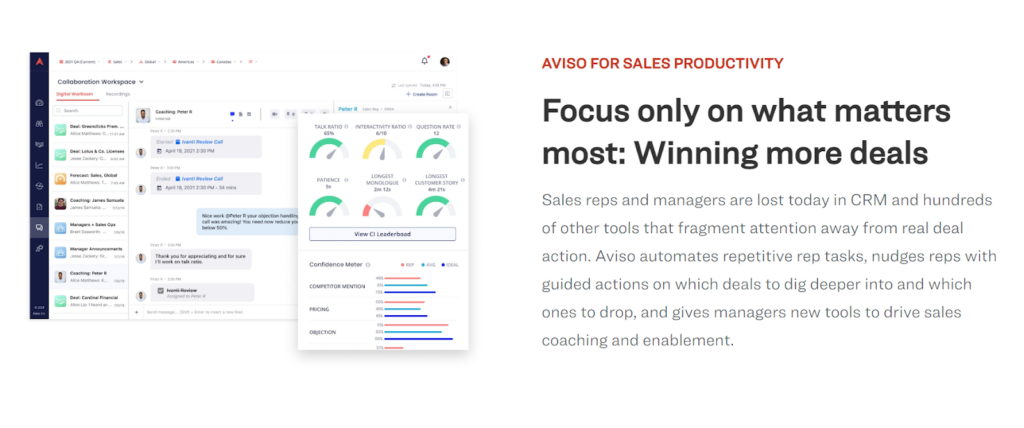
Imagine having a tool that automates those repetitive tasks your sales reps often find themselves doing, such as updating spreadsheets or sending regular emails. With Aviso, you can say goodbye to these mundane tasks and free up valuable time for your reps to focus on what they do best: closing deals.
But Aviso goes beyond just automating tasks. It also acts as a smart assistant for your sales reps. It nudges them with guided actions on promising deals to dig deeper into. This feature is like having a personal coach in the tool, helping your reps make informed decisions about their pipeline. Aviso ensures your sales team is spending their time and effort on the right opportunities, ultimately increasing their chances of success.
Top features:
- 80/20 winning insights
- Personalized coaching rooms
- Customer sentiment and emotion mapping
3. Dooly
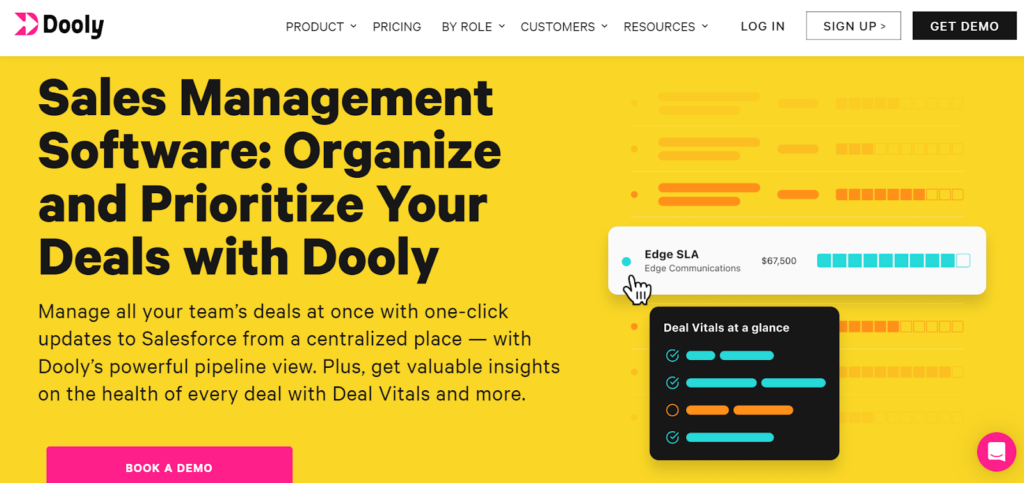
Dooly allows you to manage all your team’s deals simultaneously, providing a centralized and organized view of your entire pipeline. It keeps everything in one place, making it easy for you to stay on top of your team’s sales activities.
With just one click, you can update Salesforce directly from Dooly, eliminating the need for manual data entry or switching between multiple tools. The tool ensures Salesforce records are always up to date, saving you and your team valuable time and effort.
Top features:
- All the information in one place
- No need to log into Salesforce
- Team selling
- Better handoffs and communication
4. Introhive
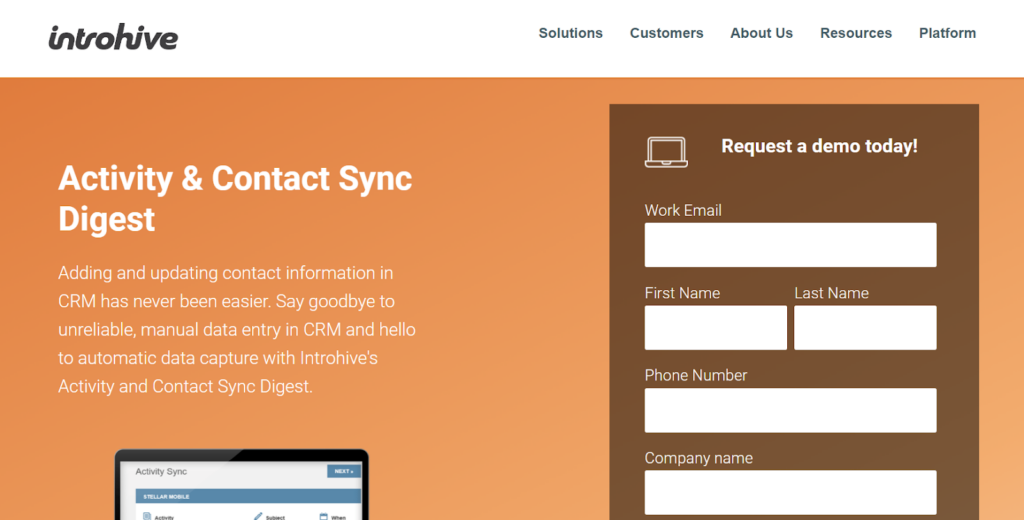
Introhive simplifies the process of entering data manually or relying on unreliable sources for contact details. The platform simplifies the process by automating data capture and sync, saving you time and ensuring accurate information in your CRM.
With Introhive’s Activity and Contact Sync Digest, you can capture data from email signatures or calendars and have it automatically added or updated in your CRM. It’s like having a personal assistant who handles data entry for you, freeing up your time to focus on more important tasks.
Top features:
- Unearth New Relationships
- Maintain a 360-Degree View
- Predictively Service Your Clients
- Create Checks & Balances
5. Rollio
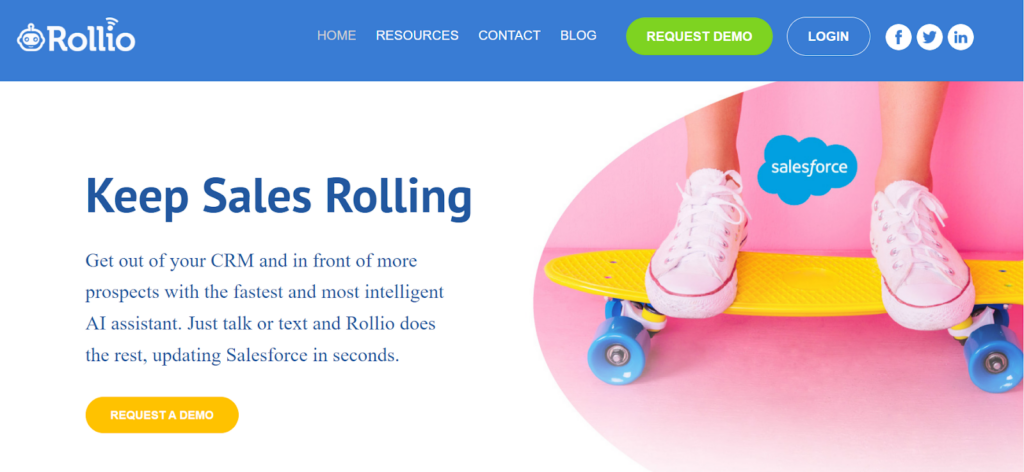
Rollio automates manually updating the CRM and saves time to be spent on engaging with prospects and closing deals. It streamlines the process, allowing you to focus on what you do best.
Rollio goes beyond just automating data entry. It acts as a proactive assistant for your sales reps, alerting them to update opportunities and follow up immediately after meetings or key events. You’ll receive timely reminders and notifications, ensuring no opportunity slips through the cracks.
Top features:
- AI-driven natural language processing (NLP)
- Intelligent notifications
- Update Salesforce in seconds
6. Sync.ai
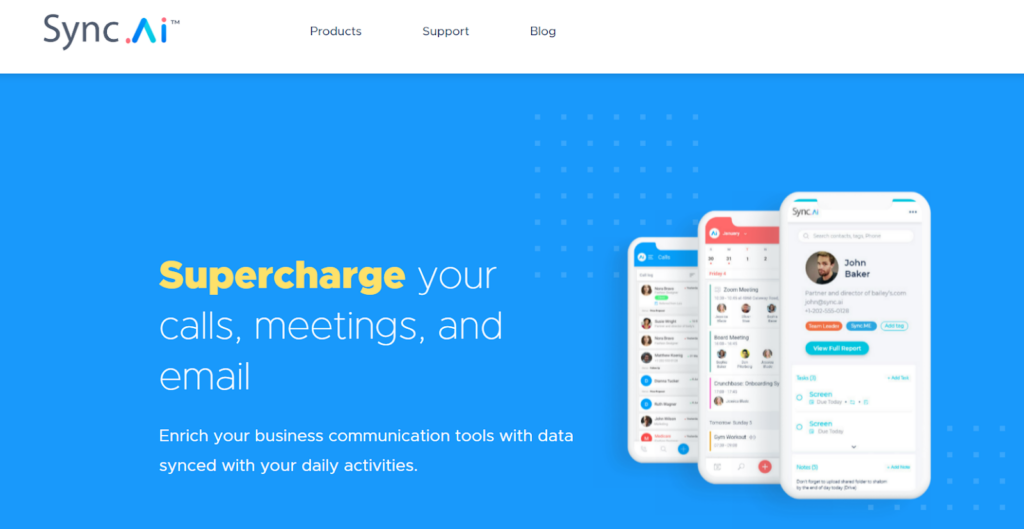
Sync.ai is a leading sales tracking tool designed to maximize productivity by integrating all your communications tools. The platform brings them together in one unified platform through calls, emails, or meetings. It reduces the hassle of switching between applications or searching multiple platforms for the needed information.
Sync.ai helps gain valuable insights and context about your interactions. It gives detailed information about a contact’s past interactions, preferences, or social media profiles.
Top features:
- Contact and company insights
- Organize and prioritize incoming leads
- Data augmented emails
7. InsightSquared
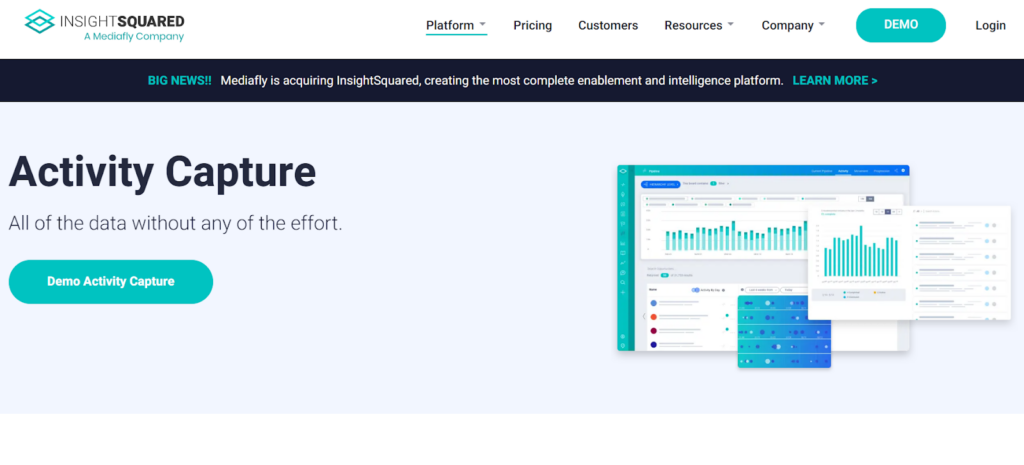
InsightSquared automates activity data collection from every RevOps department and seamlessly integrates it into your CRM. It allows for the streamlining of processes and ensure all relevant activity data is automatically captured and stored in the CRM.
Top features:
- Enrich your CRM Data
- Improve productivity
- Gain full pipeline visibility
8. Salestrail

Salestrail eliminates manual data entry of updating Salesforce. This sales tracking tool automatically tracks calls, emails, and events, seamlessly integrating them into Salesforce. No more spending valuable time logging activities or worrying about missing important details.
It can be tailored to fit unique sales processes and workflows of a business. With call lists and smart actions, you can stay on top of your sales activities and never miss an important opportunity.
Top features:
- Business Card Scanner
- Custom Fields and Forms
- Salesforce Workflows
9. Parabola.io
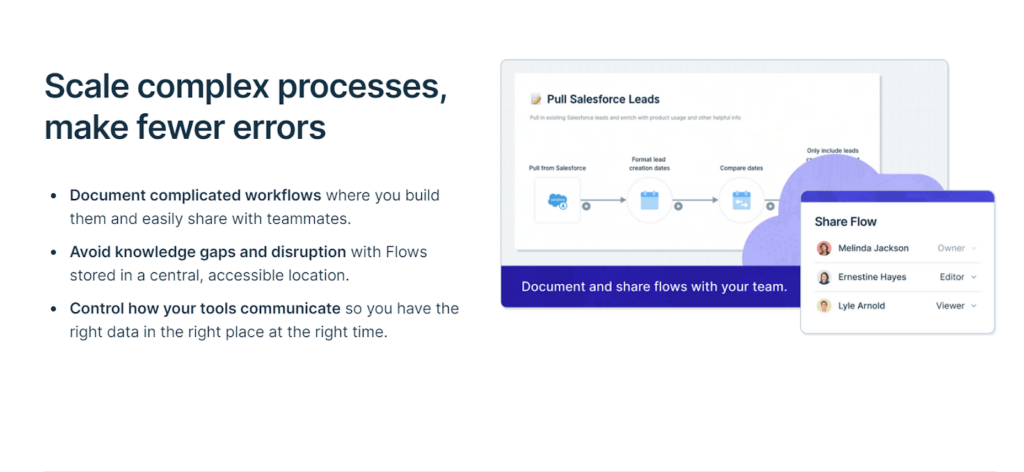
Parabola.io helps document intricate workflows, making them easy to understand and replicate. These documented workflows can be shared with teammates, ensuring everyone is on the same page.
This sales tracking tool also allows to build internal tools with a logic that matches your unique process. It helps capitalize on valuable product data that can directly impact revenue.
Top features:
- Document and share workflows with your team
- Customer health data insights
- Sales ops automation
10. Relatas

Relatas is a sales tracking tool that tracks sales activities and analyzes them using advanced AI algorithms. It sifts through emails, calendars, and call logs, to identify patterns, trends, and potential leads that may have gone unnoticed.
Top features:
- No data entry into CRM
- Improved reporting and forecasting accuracy
- Visibility and insights into deals at risk
- Deal room analysis
Bottom line
Finding the right sales tracking tool is all about understanding your unique needs and goals. Take the time to explore these 10 tools, try out their features, and see which ones resonate with you and your team. Remember, the goal is to find a tool that goes beyond tracking your sales activities. It should also enhance productivity, uncover insights, and help you build stronger customer relationships.
FAQs
- What is sales tracking software?
Sales tracking software is a platform designed to help businesses monitor and manage their sales activities. It typically includes features related to lead management, contact tracking, pipeline visualization, and more.
- How do you track sales?
Sales can be tracked through various methods. It includes manual tracking through spreadsheets or notebooks, customer relationship management (CRM) software, or specialized sales tracking tools.
- What is the best way to keep track of sales?
The best way to keep track of sales is by using a dedicated sales tracking tool or CRM software. These tools automate data entry, provide a centralized system for managing leads and contacts, offer pipeline visualization, and generate reports of sales activities.
- What is the best sales tracking tool?
The best sales tracking tool depends on your specific business needs and preferences. Some popular options include Nektar, Salesforce, and Pipedrive.
PUBLISHED BY






